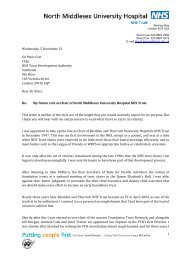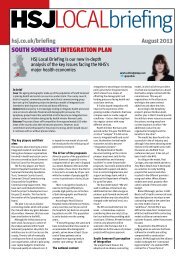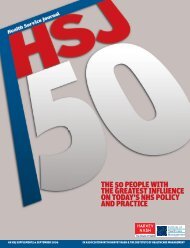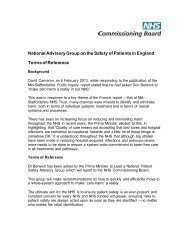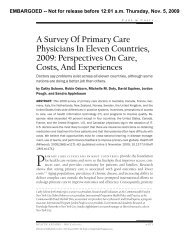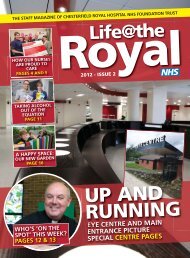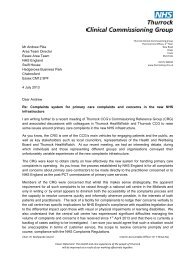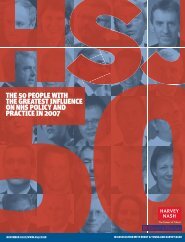HSJ Pathology Supplement - Health Service Journal
HSJ Pathology Supplement - Health Service Journal
HSJ Pathology Supplement - Health Service Journal
- No tags were found...
Create successful ePaper yourself
Turn your PDF publications into a flip-book with our unique Google optimized e-Paper software.
considerable consolidation of pathology asnormally defined – analysing samples, andproducing numbers. But the delivery of theother bits of the service needed to bedevolved as they involved closer cliniciancontact.“It is potentially tempting to suggest thatwe should commission the analysis andclinical bits separately,” he said.“As soon as you get into morecomplicated tests you need someone whocan span the bedside to the laboratory toensure that things don’t fall between thecracks. The biggest single cause of patientdamage is at the interface.”So how far will consolidation go?Professor Newland said: “I think we will see,in England, 20 to 30 hubs and I think it willbe closer to 20.” In some areas there werenot obvious hubs.“We have to have clinical pathologynetworks as well. You can’t abandon aclinical pathologist in a DGH with a smalllaboratory without proper support.“We have to have movement of staffwithin networks so we can keep them freshand up-to-date with what is going on andpart of the process.”Need for clinical networksMr Jones said it was relatively easy to getcompanies such as Roche to model what aredesigned service might look like – but nota lot of people seemed to have done thethinking around professional relationships.He had discussed this with non teachinghospitals around London and found thatclinicians liked the idea of clinical networks.He was concerned that the production sideof the transformation could run ahead of theclinical side and this could be a quality issue.KPMG associate director AdrianWoolmore said that, where clinicalleadership did not push change andrecognise the quality issues, there tended tobe stalemate, with cost driving change.“Taking 30 per cent out of pathologyservices would impact on people. Thequestion for me is how we get the clinicalleadership to take that decision,” he said.‘Phenomenal’ efficiency increaseProfessor Newland said that in hisorganisation over the past three or four yearsthe workload had increased by 20 per centbut the total budget had dropped by 4 or 5per cent; and they had 70 whole timeequivalent fewer staff through not replacingpeople when they left. This amounted to aphenomenal increase in efficiency within ashort period. Mr Sobanja commented thathe could not think of another part of thehealth service where technology had led toso much restructuring – and yet it was clearthis had not been enough.Dr Myers added: “Part of the problem isthat we see the costs as within pathology butthe costs are within the patient journey.”There was a need to look at how the costsof pathology affected the whole clinicaljourney. “I would say that pathology shouldbe delivered where we want it – if we want itnext to the patient then I think that can bedelivered.“I don’t think we should be blinkered –that we can only have a big laboratory. In 10years’ time we will have a distributedsystem.”Dr Ray Prudo, executive chairman of TheDoctors Laboratory, which offers pathologyservices, drew a comparison with othercountries. “We are 20 years behind what hashappened elsewhere. I spent 15 years inNorth America … what has happenedelsewhere is that you get what you pay for.”For example, pathologist input variedenormously and pathology providers couldbe focused on hospitals, the community orwilde FRyhsj.co.uk3 November 2011 <strong>Health</strong> <strong>Service</strong> <strong>Journal</strong> supplement 5



